Introduction to Major Languages
- Learning starts from 27 languages -
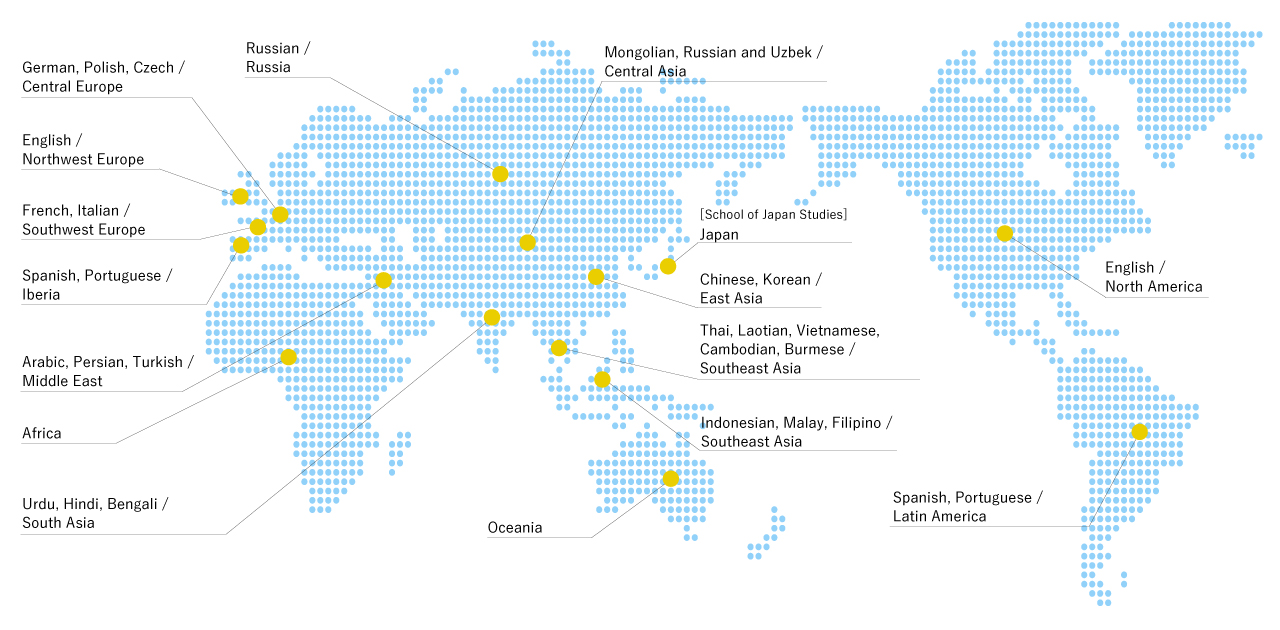
In the School of Language and Culture Studies, students will aim to gain a high level of competency in the major language that they selected at admission. Each language has its own cultural and social background, and all the schools in TUFS strive to deepen regional understanding through both the language and the region that is selected.
- 1. English
- 2. German
- 3. Polish
- 4. Czech
- 5. French
- 6. Italian
- 7. Spanish
- 8. Portuguese
- 9. Russian
- 10. Russian and Uzbek
- 11. Mongolian
- 12. Chinese
- 13. Korean
- 14. Indonesian
- 15. Malay
- 16. Filipino
- 17. Thai
- 18. Laotian
- 19. Vietnamese
- 20. Cambodian
- 21. Burmese
- 22. Urdu
- 23. Hindi
- 24. Bengali
- 25. Arabic
- 26. Persian
- 27. Turkish
Acquiring advanced English competency to play a leading role in a new multicultural society
English

English occupies a unique position in today’s world. It is spoken not only by people in the United Kingdom and the United States as the mother tongue and recognized as an official language of India and other countries, but also widely used as a language of international communication in public and private settings. Equipped with English skills as a tool, people can collaborate as well with those in non-English-speaking countries and participate in the dynamic work of creating a multicultural society on a global scale. Furthermore, English is used as the language of academics in various fields. Using English as a key can open an academic door to pursuing “truth.”
For many students entering our university, English may have been their “best subject,” but the school curriculum up to the high school level is English for children. In this major, programs are provided to boost those English skills up to the level of English for adults.
The lectures in the five classes a week in the “major language” that are assigned to first-year and second-year students are aimed at improving overall English skills, as well as exploring various aspects of the English language as the subject of academic study and developing insight into understanding English-speaking regions, which are undergoing changes.
In the Specialized Programs in the third and fourth years, students can utilize the results of major language classes to further study linguistic characteristics of the English language and cultures in English-speaking countries. Furthermore, various specialized fields of study are available, such as general theories on linguistics and regional research, international relations, and international cooperation.
Studying Regions through Languages - Northwest Europe and North America
Direct access to a wide range of European cultures through the German language
German

What kind of image do you have of the German language? You may think it is a complex language that has complicated grammar. However, there are, of course, everyday phrases like “Guten Tag! (Hello),” “Danke! (Thanks),” and “Ich liebe dich (I love you).” The German language also played a significant role in the modernization of Japan in such fields as law, medicine, and natural sciences. Some German terms even made their way into the Japanese vocabulary, such as “Karte (medical record)” and “Messer (scalpel).”
Clearly, there are so many gateways to learning German. While German is a profoundly deep language, understanding of the language opens a path to a broader world. It is the language with which Kant, Hegel, and Nietzsche developed their thoughts; in which Bach, Beethoven, and Mozart talked about their music; in which Goethe, Schiller, Heine, and Kafka wrote their poems and novels; in which the Grimm brothers collected folklore; but also with which the Nazis stirred up the masses. These are just a few examples of how learning German enables us to directly access various parts of European culture from the past to the present. Furthermore, as German is linguistically related to English, you can expect a secondary effect of gaining a deeper understanding of English as well.
Studying Regions through Languages - Central Europe
A language that endured numerous events in the 20th century
Polish
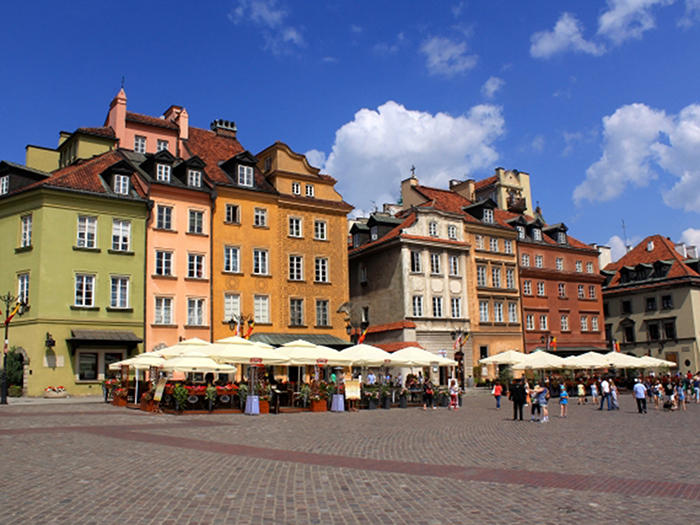
TUFS is the only university in Japan where the Polish language can be systemically studied and put to use in research. Knowledge of the Polish language is indispensable for examining the Partitions of Poland, which were historically very important to European politics and thought, and Jewish culture and the so-called “Jewish Question” that are unique to Poland, as the country at one time sheltered the largest Jewish population in the world. The Polish language went through a period of the most earthshaking events in the 20th century, including two world wars, totalitarianism, the active efforts of Pope John Paul II, the movement led by the Independent Self-Governing Trade Union “Solidarity,” and the East European Revolution of 1989. We very much hope that you, too, will master this language, which is said to be difficult to learn, and embark on a journey to directly explore not only Slavic languages and folk customs, the unique republican form of government in which kings were elected, and the history underlying the view of Marx and Engels that any Western revolution that fails to include Poland or guarantee its independence and freedom would be doomed, but also the soul and humor of Chopin.
Studying Regions through Languages - Central Europe
The most interesting thing about the Czech language is its complexity
Czech

Czech, as is obvious in the name, is the language spoken in the central European country of the Czech Republic. It is spoken by around 10 million people, by no means a large number. The language is written using the English alphabet, but, as this alone is insufficient, it is supplemented with diacritics (marks like `, v, and o) above some letters.
More than anything else, it is the complexity of the Czech language that is particularly fascinating. Most words undergo conjugation or declension, including verbs, nouns, adjectives, and even numerals.
In spite of these difficulties, students who studied the Czech language have come to love the country and graduated from the university with satisfaction. This is because the students cultivate a new perspective through the study of “a minor language” and acquire an awareness that there are things more important in the world than economic results. If you are someone who doesn’t like to follow the crowd, the complex Czech language is sure to satisfy you.
Studying Regions through Languages - Central Europe
An important international language used to describe and express a rich and fascinating culture
French

French is the official language not only of mainland France and its overseas departments and regions but also of the province of Quebec in Canada, European countries such as Belgium, Switzerland, and 22 African countries including the Democratic Republic of Congo and Cameroon. From the 17th to 19th century, French was an indispensable language for diplomacy. Even now, the French language plays a crucial role in international bodies, non-governmental organizations (NGOs), and at international events such as the Olympics. For people seeking a career in areas like international contribution and development cooperation, it is essential to master French as well as English. In addition, learning French will give you a different perspective of the world from the one learning English offers.
The canonical, authoritarian France and the individualistic, peripheral France surrounding it have, in the aspect of its language and culture, been in perpetual conflict throughout the nation’s history. In studying the French language and surrounding knowledge, you must always keep an eye on the center and the periphery, for example, the written language and oral language, France and French-speaking regions, and Paris and the provinces. Learning the French language can offer you perfect opportunities to think about such matters.
What does “French studies” call to mind? You can read and enjoy texts written by eminent writers and philosophers in the original language to heighten your thoughts and deepen your knowledge. It is also meaningful to think about what is shaping France today through intensive reading of historical documents. It may also be interesting to listen to ordinary people's everyday conversations and focus on the living language changing in response to time, place, and purpose to shed light on its mechanisms and think about its relationship with society and people. We hope you use the French language to pursue your French studies.
Studying Regions through Languages - Southwest Europe
Touching the heart of the rich and diverse Italian culture
Italian

Italy is one of the birthplaces of European culture. For example, French, Spanish, and Portuguese, the dominant languages of Europe that are now spoken widely around the world, can be traced back to the Latin language, which was spoken around the Tevere River in central Italy. Italian is also a descendant of Latin, and it is sometimes said to have maintained more of the original characteristics of Latin than these other languages in many ways.
In contrast to languages that spread worldwide through colonialism, Italian is only spoken in the Italian Peninsula and the neighboring regions (parts of Switzerland, Slovenia, Croatia, France, Monaco, etc.) Because of this, the use of the Italian language is somewhat closely tied to the country of Italy, both from the perspectives of general social life and academic research.
Located in the Mediterranean Sea, at the crossroads of various cultures and the birthplace of a rich culture, Italy is a key to understanding Europe as a whole. Studying Italian can be an invaluable experience that cannot be measured solely in terms of the size of the population that speaks the language.
Studying Regions through Languages - Southwest Europe
Nearly 500 million speakers in Spain and Latin American countries
Spanish

Counting native speakers alone, 490 million people speak Spanish. Including those studying Spanish as a foreign language, the number rises to nearly 600 million. The language is used in over 20 countries and regions, including Spain and Latin American countries. Spanish-speaking countries are becoming increasingly important. Spain has played an active part in European integration, and Latin American countries have played a crucial role in international politics by interacting with the United States through the Organization of American States. However, the societies of each country vary widely. In Spain, the Catalan and Basque languages, together with their respective cultures, remain intact. In Latin America, indigenous languages and cultures of the indigenous peoples form multiple layers with the Spanish-speaking communities.
Culturally, Spain is gaining attention in literature, thought, religion, art, music, and architecture. Today, the country is also prominent in various fields, including film, dance, soccer, cooking, fashion, and festivals. Every single aspect of these diverse Spanish-language cultures would certainly be an exciting theme to study at the university.
The curriculum of the Spanish Language Major is designed to make it possible for students to study by themselves using the Spanish language. In the Major Language Course, for the first two years, two out of five classes a week are taught by native Spanish speakers using the latest textbooks published in Spain. The objective is to develop conversational skills so that students can think and speak for themselves. In grammar classes, textbooks produced by dedicated faculty members are used to ensure that students can thoroughly and speedily grasp Spanish grammar, and they will do fundamental practices to enable them to write precise compositions. In addition, we also devote sufficient time to reading classes to enable students to read various types of Spanish texts from their own perspectives.
Studying Regions through Languages - Iberia and Latin America
Portuguese is spoken widely in Portugal and Brazil -- and Japan!
Portuguese

Portuguese is the mother tongue of over 200 million people in Brazil and Portugal. It is also the main official language of a number of African countries such as Cape Verde, Guinea-Bissau, São Tomé and Príncipe, Angola, and Mozambique, and a co-official language of Equatorial Guinea in Africa and East Timor in Asia. About 240 million people speak Portuguese, making the language culturally diverse and rich. Since the late 20th century, Japanese-Brazilian communities have existed in Japan with people speaking Brazilian Portuguese. The Portuguese language originated in the western region of the Iberian Peninsula from the colloquial and vernacular form of Latin, the official language of the Roman Empire. It is a Romance language closely related to Spanish, French, and Italian. The language flourished along with the Kingdom of Portugal, which was established in the 12th century, and cultivated its rich cultural traditions from the 13th century onward. In the 15th century, Portugal expanded overseas earlier than other European countries, playing a significant role along the African coast, the Indian Ocean region, and the Far East until the first half of the 16th century. Portuguese was the first European language with which the Japanese people directly interacted.
After admission, students enrolled in the Portuguese Language Major will receive intensive language education in the first and second years. In the third and fourth years, the focus of education shifts to seminars in specialized fields provided in the courses of the respective School. Students can design their own program of courses to take in line with a theme or an interest, and study the society, economy, politics, and history of Brazil, Portugal, and other Portuguese-speaking regions, with the possibility of also studying their literature and linguistics, cultural studies, and issues supporting development. From the time of admission, the major language staff responsible for the education of new students will consist of faculty members specializing in the language, literature, and history of Portugal and Brazil and in Brazilian studies, etc.
Studying Regions through Languages - Iberia and Latin America
Studying the unique writing system and language, and understanding the culture of Russia
Russian

TUFS is one of the earliest institutions in Japan to conduct research and education regarding the Russian language and region (The Tokyo University of Foreign Languages was established in 1873 with Russian as one of the five majors.) Although there are a few other universities with departments that focus exclusively on linguistics or literature, TUFS is the only one with an organization designed for comprehensive Russian studies, including regional research.
Russia is the closest country to Japan, yet the paths toward mutual understanding are still inadequate. There is a need to open them up in various ways.
Japan needs new human resources who have mastered a high level of competency in the Russian language and acquired sufficient knowledge about Russian society and culture to increase mutual understanding and networking in various situations. Let's gain a broad range of knowledge about the Russian language, culture, society, history, economy, etc., to deepen our understanding of Russia, and, through such understanding, cultivate an eye for looking at the modern world.
In the first and second years, students in both Schools devote a lot of time and energy to mastering Russian. Students are encouraged to gain solid competency in using Russian while remaining focused on what first interested them about Russia. Throughout their third and fourth years, students in each School will join one of three courses according to their interests to commit to a research theme. In the Russian major, students are encouraged to have broad interests in issues of other fields, because, if they decide to research a work of Russian literature, it is not possible to think deeply about it without knowledge of the era and the society in which the author lived. Moreover, many students study abroad in a number of regions in Russia through various routes, learning valuable lessons through interactions with people and seeing how they live.
Studying Regions through Languages - Russia
Russian - A common language of Central Asia, an area with abundant natural resources
Uzbek - A representative language of the Silk Road, the intersection of civilizations
Russian and Uzbek
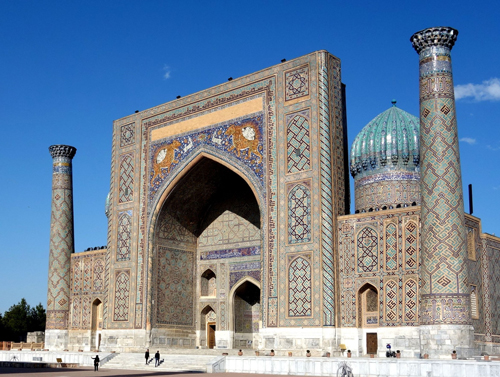
Russian still plays a key role as the lingua franca of the Central Asia region, once a part of the former Soviet Union, where many local people speak the language.
Uzbek, the national language of the Republic of Uzbekistan, is the most widely spoken language in Central Asia, with 34 million speakers in Uzbekistan and neighboring countries. Uzbek is related to Turkish, along with other Central Asian languages like Kazak, Kyrgyz, and Turkmen. The grammatical structure resembles that of Japanese, such as postpositional particles and word order, making it one of the easier languages for Japanese to learn.
TUFS is the only university in Japan with an Uzbek Major, a major that requires students to learn two languages, Russian and Uzbek. In the first year, students learn Russian as the common regional language. In the second and third years, they learn Uzbek as a representative Central Asian language.
Located in the middle of the Silk Road, Central Asia has embraced various cultures from all sides as the intersection of civilizations from ancient times to develop its own culture and history. By studying Uzbek, which has been enriched with imported words from Persian, Arabian, and Russian, students will gain an understanding of the layers and complexities of the region’s diverse cultures. From the third year, many students study abroad at partner universities in Uzbekistan and Kazakhstan to further deepen their understanding through local experience.
Studying Regions through Languages - Central Asia
The nomadic lifestyle and language of resource-rich Mongolia
Mongolian
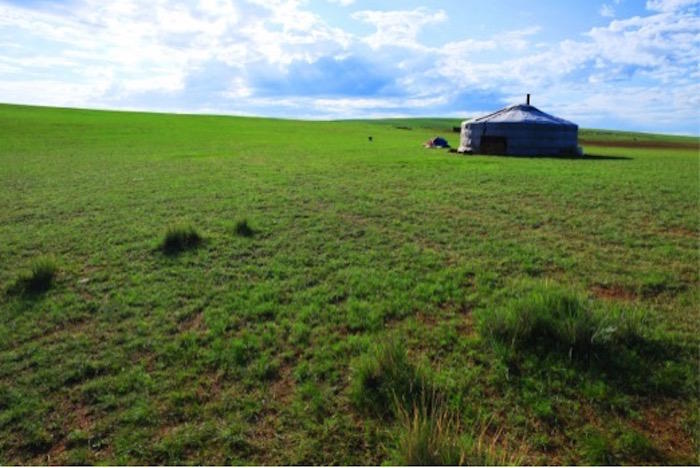
The Mongolian Language Major at TUFS is one of the few programs in the world where the research on Mongolian society and culture is based on studying the Mongolian language. Mongolian studies in Japan are highly acclaimed as among the best in the world. Our university's Mongolian Language Major has a history of more than 100 years and has contributed to maintaining the high standard of Mongolian studies in this country. Every faculty member specializes in the language, history, or other aspects of Mongolia, making it possible to support the various requirements and interests of the students.
The Mongolian people have established a nomadic culture in the grasslands of northern Central Asia. Let's explore the attractiveness of the nomadic society, which is totally different from settled agricultural communities.
Since the word order of the Mongolian language is the same as that of Japanese, it is a relatively easy language for Japanese people to learn. Therefore, in the classroom, the focus is on understanding those grammatical characteristics that differ from Japanese and mastering pronunciation not found in the Japanese language. Native speakers among our faculty members teach pronunciation from the basics to make pronunciation easy to learn.
Studying Regions through Languages - Central Asia
A language that reflects the life and mind, and the society and history of East Asian people
Chinese

The Chinese Major has one of the longest histories at TUFS and has consistently supported Chinese language education in Japan since the Meiji era. As China strengthens its presence in international society, demand for the Chinese language has been increasing daily. In our Chinese classes, we focus on practical language skills while maintaining the basic policy of mastering grammar and usage crucial for advanced research.
Most of the textbooks used for major language courses in the first and second years were edited to create texts that are TUFS originals. Since they are created in accordance with the composition and basic approach of the classes, their structure and contents are specially designed for reading, grammar, and conversation classes. The volume of material to learn is large and of a high level for first-time students, but they should be able to master the advanced-level language in two years by studying intensively. For conversation classes, the regular class of 30 students is divided into two groups of 15 students each to teach them in smaller groups.
Studying Regions through Languages - East Asia
Experience and research in depth the language, culture, and history of our neighbor
Korean

TUFS is one of the few universities in Japan where students can engage in specialized studies and research related to the Korean Peninsula. In addition to developing a good command of the Korean language, students can also experience and research in depth various fields, such as the Korean language in terms of linguistics, and the history and culture of the Korean Peninsula. All the faculty members are researchers who are active at the forefront of Korean studies in Japan. As TUFS also has a graduate school related to Korean studies, it provides integrated, high-quality Korean studies from undergraduate to doctoral programs.
In the first and second years, there are five Korean language classes per week. The faculty members work closely with one another to provide systematic classes so students can smoothly master the language. Native speakers teach two out of five classes so that students can fully experience the living Korean language. In the third and fourth years, there are classes conducted in Korean to provide a simulated study-abroad experience. Furthermore, TUFS has over 100 international students who speak Korean that TUFS students can talk with in Korean at any time. The university is fortunate to have a favorable environment where students can properly learn and actually use the Korean language.
Studying Regions through Languages - East Asia
Learning the language of Indonesia, a land of rich and diverse cultures
Indonesian

Indonesia is a large country where over 250 million people live on more than 13,000 islands spreading from east to west over an area that exceeds that of the United States. The country has a rich and diverse culture developed over its long history and is closely related to Japan in many fields. Studying Indonesian is of great significance both now and in the future.
The small class structure that is a distinctive feature of the Indonesian Major makes methodical instruction of the Indonesian language possible, and it is this bountiful learning environment that enables students to study the Indonesian language and carry out regional research on Indonesia. Although other universities provide Indonesian language classes, TUFS's Indonesian Major is characterized by intensive and focused studies on the Indonesian language and regional research. In the first and second years, students study the Indonesian language intensively as their major language. Specifically, in the first year, teaching materials that have been edited in-house are used to ensure that students acquire basic language skills from the introductory level. In the second year, conversation, reading, and writing classes are taught in a balanced manner to improve applied and practical skills. In parallel with language classes, a comprehensive understanding of Indonesian regions is nurtured through classes on Indonesian history, culture, and society. In the third and fourth years, students will utilize the language skills, regional knowledge, and methodology they have learned to research in more depth a theme selected from various fields according to their interests.
Studying Regions through Languages - Southeast Asia 1
A common language connecting Southeast Asia
Malay
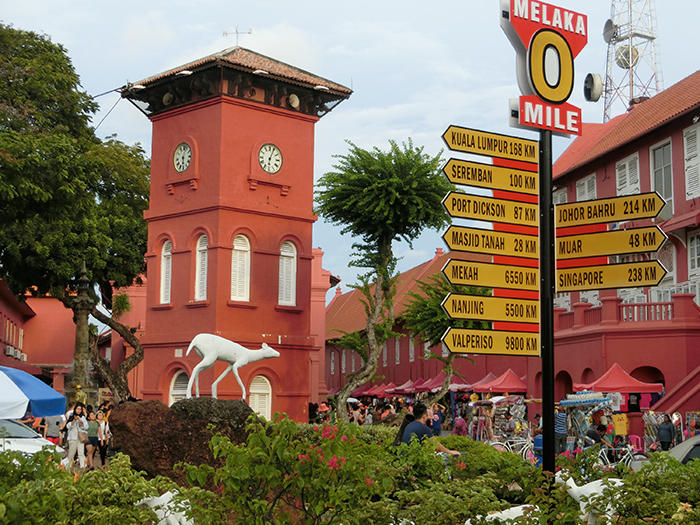
How about taking a look at Asia through the window of the Malaysian language? In Malaysia and its neighboring regions, various people, goods, and civilizations have come and gone across the seas of Southeast Asia since ancient times. As a result, Malaysia has become a multilingual, multicultural society like a microcosm of Asia, where Malays, various indigenous people, Chinese, and Indian people coexist. The Malay language, which has long been spoken as a lingua franca over the wide area of the Southeast Asian islands, has been standardized as Malaysia’s national language.
The Malay language program at TUFS was established in 1984, but it has a history of over 100 years, including the Malay Department before World War II. TUFS is the only university in Japan with an independent Malay language program, making it particularly valuable.
The first goal of our education is to have students master balanced skills in reading, writing, listening, and speaking the Malay language. First, we use our own teaching materials to teach grammar, reading comprehension, conversation, and expression to master the basics of Malay. In addition, students read newspapers, magazine articles, literary works, and academic books to learn contemporary Malay as used in journalism, culture, the arts, and academic fields. In classes taught by faculty members who are native speakers, students practice conversation and strengthen their listening skills using local video and audio materials, and improve their presentation skills through essay writing and oral presentations.
Our second goal is to have students improve their understanding of Malay society using the Malay language skills they have acquired. In our Introduction to Malay Studies class, students learn basic knowledge of Malaysian history, society, culture, politics, and economics and study the fundamentals of regional research. There are a number of classes related to Malaysia and the Southeast Asia region in specialized classes, so classes can be selected according to the interests of the students.
Teachers who are native speakers offer optional study tours, which many first-year students take part in. Every year, some students go overseas to study and gain valuable experience at universities in Malaysia, Singapore, and Brunei.
Studying Regions through Languages - Southeast Asia 1
Studying the language and society of the Philippines and learning about its multilingual, multicultural society
Filipino
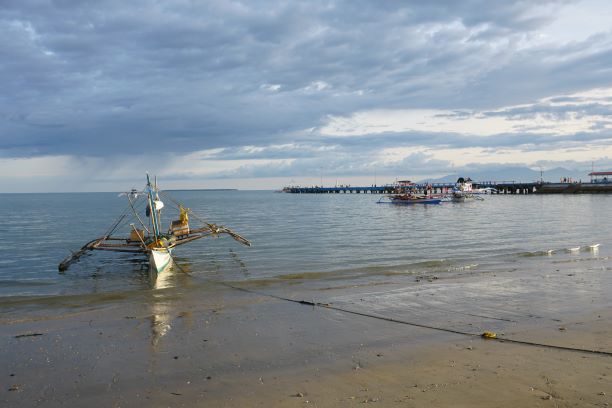
Currently, more than 120 languages are spoken in the Philippines. The long list includes English and various dialects of Chinese, but most of these languages are indigenous to the Philippines and descendants of the same ancestral language. In the Filipino language program at TUFS, students learn one such language, Filipino (Tagalog), and know about the societies and cultures of the Philippines. Filipino, the national language of the Philippines, is not only widely spoken domestically but also spoken in various regions outside the country, and the number of speakers in Japan is by no means small. Therefore, studying in the Filipino language program not only enhances understanding of Filipino culture and society but also leads to a deeper understanding of Japanese society, which is becoming increasingly multilingual and multicultural.
The Filipino language program at TUFS features small-group classes, where learning takes place in an attentive and amicable environment. Students study Filipino grammar, reading, and conversation in the first and second years. In addition to classes using grammar textbooks, listening skills are enhanced through video materials such as local movies; speaking skills and presentation-making skills through oral presentations. At the same time, students will gain comprehensive knowledge of the Philippine region through lectures on Filipino society and culture. In the third and fourth years, students make use of various approaches in working on their own research topics based on the Filipino language skills and regional knowledge they have acquired.
Major Language Lessons: Filipino Grammar / Filipino Conversation / Filipino Reading Comprehension /Filipino Composition
Studying Regions through Languages - Southeast Asia 1
Comprehensively learning the dynamically developing Thai language, culture, history, politics, and economy
Thai

The regional integration and economic development of Southeast Asia have been rapidly progressing since the establishment of the ASEAN Economic Community in 2015. The region with the most significant progress in transportation infrastructure and economic integration is mainland Southeast Asia, also known as the Indochina Peninsula. Thailand is located at the center of the peninsula and is an icon of the economic development of mainland Southeast Asia. Bangkok, the capital city of Thailand, was once abundant with water and known as the Venice of the East. Now it is a mega-city with overhead railways and subways, skyscrapers, and traffic jams every day. In the city center, there are traditional Buddhist temples and old shopping streets, while many large shopping centers line the main streets, convenience stores crowd every street corner, and many Japanese restaurants are growing in popularity. Japanese automobile manufacturers and related companies have established bases in industrial parks in the east part of Bangkok, and Thailand has become such a huge base of the manufacturing industry that it is known as the Detroit of Asia. On the other hand, when you leave metropolitan Bangkok and travel to rural locations, you can see rural scenes such as rice-growing areas, oil palm plantations, rubber tree plantations, and durian orchards. While maintaining its traditions, Thailand is changing dynamically amidst modernization and globalization.
The Thai language education and research curriculum at TUFS is aimed at the comprehensive study of the history, culture, politics, and economics of this rapidly progressing country based on the Thai language. The Thai language classes are based on modules of a half-term with five types of classes offered at each level. In the first year, students must take five classes per week to learn the basics of the Thai language. In February, students participate in a short visit to Thailand for Thai language and culture research conducted by a partner university in Bangkok. In the second year, students take five intermediate-level Thai language classes per week to improve their Thai language skills. In the third and fourth years, intermediate to advanced Thai language classes are offered. In addition, from the third year on, many students study abroad at partner universities in Thailand such as Chulalongkorn University, Thammasat University, Srinakharinwirot University, and Chiang Mai University. At the same time, students from the partner universities in Thailand come to study at TUFS, making it possible for TUFS students to have interactions with students from Thailand on an everyday basis. At the Gaigosai university festival in autumn, first-year students cook and sell Thai cuisine and second-year students perform a play in the Thai language. While learning about Thailand, students develop their international sensibilities and thoroughly enjoy student life.
Studying Regions through Languages - Southeast Asia 2
The Language of Laos, “a country of forests,” and the character and appeal of its people
Laotian
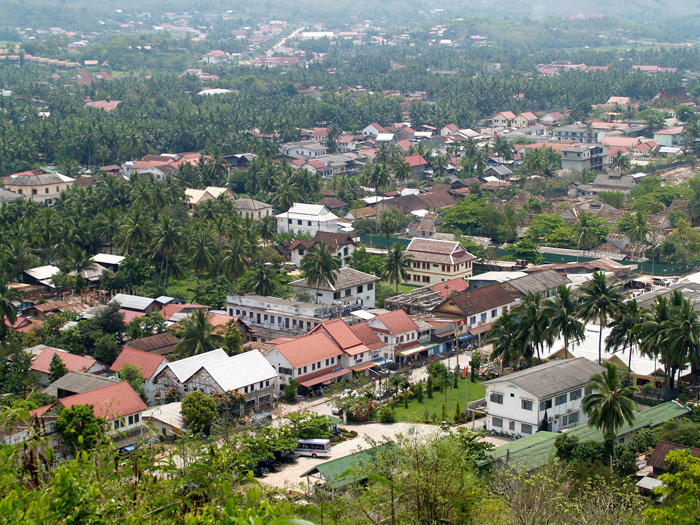
The Laotian Language Major is one of the newest language majors in the long history of TUFS. It is the only university in Japan that comprehensively teaches Laotian and, with only a few other places worldwide such as China, that fully teach this language.
The country of Laos may not be well known to the Japanese people, but, in 2015, Japan and Laos celebrated the 60th anniversary of the establishment of diplomatic relations. The relationship between the two counties has been deepening through economic assistance and cultural exchange. Rapid economic growth in recent years has significantly changed Laos, but much of its traditional culture remains in townscapes, where greenery and nature can be seen everywhere. In the Laotian Language Major, students can learn about the culture, society, and history of Laos and neighboring countries through their studies in the Laotian language. We hope that students will develop an awareness of issues through Laos, determine their own questions regarding the issues, and be willing to make sincere efforts.
The goal for the first year in the Laotian Language Major is to become able to handle basic reading and writing, conduct daily conversations, and read short texts. As this is one of the language majors with module-based classes, the curriculum is designed to enable students to complete classes in grammar and script quickly, and then study categories such as vocabulary, composition, reading comprehension, translation, and conversation, which increase difficulty step by step. Accordingly, the students develop their own individual study plan to learn the language. At the same time, students study the basics of Laotian society and must give a presentation on a theme of their choice. Making use of the exchange student program, some students also study abroad at the National University of Laos, a partner university of TUFS.
In addition to using textbooks developed in-house, excerpts of articles and passages from current books and newspapers published in Laos are used to raise awareness of Laotian culture and society. Students will also be able to listen to the contemporary Laotian language and hear useful news about Laos from Laotian faculty members.
Studying Regions through Languages - Southeast Asia 2
An emerging country with a long history spanning Southeast and East Asia
Vietnamese

Established in 1964, the Vietnamese Language Major has a history of education and research going back more than 50 years. This major is a unique education-research unit that covers a wide range of humanities such as language, literature, etc., and social sciences courses such as history, economics, and society related to Vietnam.
In the first two years, students enrolled in the Vietnamese Language Major learn the Vietnamese language and the basic knowledge required for specialization. Then they proceed to the core seminar course for the next two years to systematize their knowledge and acquire specialized analytical methods under various research themes. At the same time, they develop multi-faceted academic perspectives and ways of viewing Vietnam as “a region of the world.” We welcome highly motivated students who wish to study Vietnam not only as one country but from the broad and specialized perspectives of the world at large.
To develop the four language proficiency skills such as reading, writing, listening, and speaking comprehensively, a module-based language education is provided in which students study in the five courses of grammar, reading comprehension, expression, listening, and conversation at incrementally increasing levels of difficulty. Efficient language education is carried out by faculty members with many years of educational experience, using teaching materials developed specifically for Japanese students. Vietnamese-only classes are also provided by visiting instructors from Vietnam. The synergistic effect, with the active participation of students in these classes, has led to remarkable results. In addition, “media translation” is carried out, which involves the translation of Vietnamese newspaper articles and publishing them on the university website. In the second-half seminar course, students receive mentoring based on the learned language to acquire systematic knowledge and methodology of their selected specialized research theme and have achieved an excellent level of success.
Studying Regions through Languages - Southeast Asia 2
A language of culture symbolized by Angkor Wat
Cambodian

Surrounded by Vietnam, Laos, Thailand, and the sea, Cambodia has an area of approximately 180,000 square kilometers, almost half the size of Japan, and a population of about 15 million. Flourishing since ancient times, the country has magnificent archaeological sites such as Angkor Wat and a language with inscriptions dating back to the early 7th century. In addition to being a popular travel destination, Cambodia has recently been gaining attention as a place of international cooperation in fields such as archaeological site restoration and education.
The Cambodian Language Major was established in 1992. TUFS is the only university in Japan with a program for studying Cambodia systematically over four years and engages in a student exchange with the Royal University of Phnom Penh. Even worldwide, only the University of Paris has a similar program.
Under the careful, thorough instruction by three faculty members, one of whom is non-Japanese, approximately ten students in each grade proactively study the Cambodian language and about the Cambodian people and society. Moreover, many of the extensive Cambodian-language materials needed to complete the graduation research project are available only in the Cambodian Language Major.
There are still many unexplored areas in Cambodian studies. We welcome students who are filled with curiosity and willingness to challenge the unknown and persistently pursue their research, and even after they graduate, wish to continue translating literature, interpreting temple murals, collecting riddles, and analyzing political and economic trends from daily news as lifelong hobbies.
In this major, the goal is for students to acquire logical thinking ability and rich skills of expression in addition to accumulating knowledge while studying the Cambodian language for four years at the university. To this end, we provide module-based classes with clear-cut categories and levels and use original introductory textbooks, dictionaries developed in-house, and audiovisual materials as well as supplementary reading materials sent over from Cambodia.
The first two years focus largely on learning the Cambodian language. Because the beginners’ textbooks are meticulously designed based on comparative research of Japanese and Cambodian grammar, students can easily meet the seemingly tight schedule of completing the study of basic grammar and starting to read folk tales in two months. From the second year, more practical language proficiency skills are cultivated. Students join a seminar in the third and fourth years to prepare for their graduation thesis or graduation research.
Studying Regions through Languages - Southeast Asia 2
Myanmar: a nation in the spotlight with a language filled with great potential
Burmese

Myanmar has long been seen as a country with great potential due to its abundant natural resources, such as crude oil and natural gas. It is a diverse country with 135 officially recognized ethnic groups living in a rich variety of natural environments from the 5800-meter-high Mt. Hkakabo Razi in the north to the fertile delta region. With democratization moving forward since 2010, Myanmar had been seen as Asia’s last frontier, but, since the 2021 coup d’état, conflicts between civilians and the military have been intensifying again throughout the country. There has long been a strong affinity toward Japan, and it is now a time when many young citizens are considering traveling to Japan to find new opportunities. Amidst these circumstances, we are now faced with a valuable opportunity to think about what we can do as Japanese people. The Burmese Language Major was established in 1981 as the second program in Japan where the Burmese language can be systematically studied as a major. Historically, the University of London in the United Kingdom has been at the center of Burmese studies. Subsequently, however, Japan, as well as other countries such as France and the United States, has begun to gain a reputation as one of the major centers of research.
The Burmese Language Major is designed to enable students to first learn the Burmese language and then study various disciplines in humanities and social sciences to find what they want to study. This is a starting point that is different from that of many universities where students study disciplines first. By learning the languages of other people and then actually meeting them, it becomes possible for students to have their own awareness of issues. We hope to welcome into the Burmese Language Major applicants who are not afraid of encountering and going head-to-head with real people and are looking forward to doing so.
The Burmese Language Major provides module-based education in accordance with each level and category. The goal of students in the beginner and intermediate classes is to learn the basics of colloquial Burmese sufficient for everyday conversation. With the exception of one commercially available teaching material, all of the other teaching materials for grammar, reading comprehension, and vocabulary were prepared in-house and designed for use in the modules. In the first semester of the first year in particular, faculty members communicate with each other to provide intensive instruction in the basics of letters, pronunciation, and grammar. Moreover, nearly half of the classes are taught by Burmese faculty members, who provide thorough pronunciation and conversation lessons. From the second year, students are introduced to the written language and are required at the advanced level to have reading comprehension and communication proficiency skills so that they can read and discuss local newspapers, journals, and essays. The ultimate aim of the program is for students to acquire language proficiency skills that enable them to use local materials freely for their graduation thesis and their job or experience no difficulties when visiting Myanmar.
Studying Regions through Languages - Southeast Asia 2
Pakistan’s national language and common language for Muslims in South Asia
Urdu

Urdu is the national language of Pakistan, which upholds Islam as a unifying national ideology. Although Hindi is an official language of India, it shares the same grammatical structure and everyday vocabulary with Urdu. Therefore, Hindi and Urdu are actually two different styles of a single language. The two languages are widely spoken throughout South Asia as common practical languages. The total number of speakers of these two languages makes them the third-most widely spoken language in the world, behind Chinese and English. Around 60 million people speak Urdu as their mother tongue, but approximately 400 million people understand the language. Historically, Urdu has been more closely related to Islam than Hindi, because Muslims have used it as their primary language of literature. The scope of research in the Urdu Language Major broadly covers Indo-Islamic culture at the crossroads of the cultures of the Indian and West Asian worlds.
Specifically, among the languages spoken in the surrounding regions, the interconnection of Urdu with Persian, Turkish, and Arabic, which are languages that are prevalent toward the west, is deeper culturally because of the relationship with Islam. Toward the east, Urdu shares the same linguistic lineage with Hindi and Bengali, forming the so-called “Indian world.” Urdu plays a vital role in connecting these different worlds.
The Urdu Language Major provides students with a carefully designed language education system. In the first year, students begin by learning to read and write the Arabic characters (Urdu characters) used to write Urdu and then study basic grammar and conversation. From the second year onwards, students endeavor to get the grammatical knowledge learned in the previous year to take root, and, using the local news as subject matter, interpret the contents and understand the background of those news stories, and learn the differences between Japanese and Urdu by practicing translation from Japanese to Urdu. Importance is also placed on running a food stall and performing an Urdu-language play at the Gaigosai university festival as an opportunity to demonstrate what students have learned. In such ways, the mastering of the living language, cross-cultural understanding, and communication with South Asia form the pillars of our education.
Studying Regions through Languages - South Asia
An official language of India, encompassing diverse and rich history and culture
Hindi

Hindi is an official language of India. According to the most recent census, the Hindi-speaking population is estimated to be well over 500 million. In addition, it is said that the number of immigrants living in various parts of the world who speak the language reaches 30 million. TUFS is one of the few academic institutions in Japan where this language can be studied up to the doctoral level.
Students start their studies by learning Devanagari, the script used for writing Hindi. They then develop practical proficiency skills, while broadly studying India’s history, culture, and society. Since the liberalization of its economy in 1991, India, which is continually undergoing rapid changes, has been attracting our attention. It goes without saying that the India of today is a constant topic of discussion.
Classes are taught in accordance with a module-based curriculum. After acquiring language skills, students pursue their own interests to read and interpret a vast collection of written materials in various fields and representational cultural materials such as movies and theater. The final culmination is the writing of the graduation thesis. Whether they start working after graduation or proceed to graduate school, students will have acquired both practical and specialized knowledge.
Studying Regions through Languages - South Asia
The national language of Bangladesh, east of India -- Home of the profound Bengali culture
Bengali

Bengali is a language that has developed over a long time in the region facing the Bay of Bengal at the eastern end of the Indian subcontinent. The Bengal region, which is the birthplace of Rabindranath Tagore, the first non-European to receive the Nobel Prize in Literature, has a long literary tradition. Another distinctive feature of the Bengal area is its diverse cultural background, with many Muslims living in the east and many Hindus in the west. With this diversity and depth, the Bengali language serves as the core of the totality of Bengali culture that transcends national and religious frameworks. Bengali is currently spoken by over 250 million people as the national language of Bangladesh, the official language of the West Bengal State in India, and by Bengali people living all over the world.
Students can study the multi-layered Bengali culture and further deepen and widen their knowledge in the only Bengali Language Major in Japan.
Studying Regions through Languages - South Asia
One of the official languages of the United Nations – The world cannot be understood without knowing the Arab world
Arabic
Arabic is one of the official languages of the United Nations and is used in many countries in West Asia and North Africa. The language also has great significance for Muslims worldwide as the words of the Quran. Unfortunately, however, there are few people in Japan who can understand the language, and therefore it is not possible to hear directly what the voices of the people in the Arab world are saying. The Arabic language certainly sounds unfamiliar to us and is a difficult language to learn. Furthermore, the Arab world is a profound world that is neither a part of the West nor a part of the East. But that is what makes the language a fascinating subject to study at the university.
Arabic language education starts in the spring semester of the first year with an emphasis on conveying an overall image of Arabic grammar and teaching the basics of communication through the language. From the fall semester, students strive to improve their practical Arabic skills, with a focus on categories such as conversation (al-Fusha), listening, composition, and reading comprehension. In the winter semester, students take part in one month of language training in Egypt or Jordan as an opportunity to experience firsthand the Arab world. In the spring and fall semesters of the second year, students further improve their proficiency skills in the above categories and try translating newspaper articles in the Arab world as part of the “Reading Middle Eastern Media in Japanese” project. From the third year onward, students will follow their academic interests to study, for example, reading comprehension, expression, discussion, or colloquial dialects (al-Ammiya).
Classes are taught not only by Japanese faculty members but also by Arab members from countries such as Syria and Egypt. Overseas students from Arab countries participate in some classes, such as conversation classes. These classes are valuable opportunities to learn about Arab culture in addition to the Arabic language. Moreover, students are expected to cultivate their practical Arabic skills and knowledge of the Arab world through interaction with students in study abroad programs from Egypt, Jordan, Oman, Morocco, and Syria, as well as online classes that are linked with Syria as part of the international co-education program.
Studying Regions through Languages - Middle East
The official language of Iran, Afghanistan, and Tajikistan
Persian
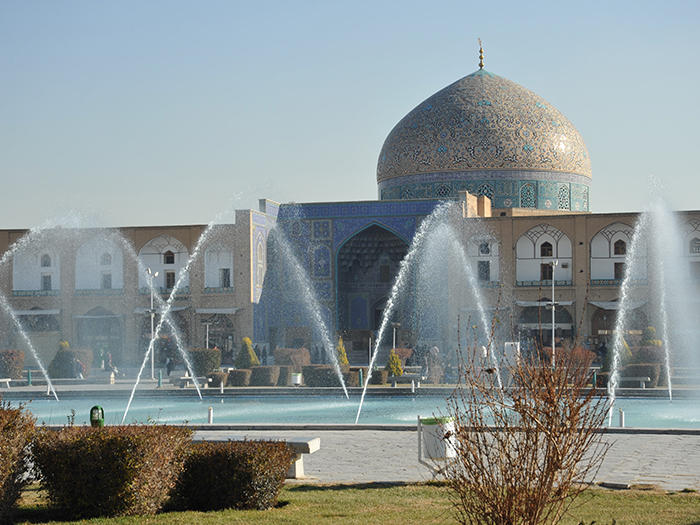
Persian, sometimes called the “French of the East” because of its beautiful sound, is the official language of Iran, Afghanistan, and Tajikistan. A question that is often asked is, “How is Persian different from Arabic?” because the two languages are written using the same script. Persian belongs to the Indo-European language family, and Hindi and Urdu are its closest relatives in neighboring South Asia.
Persian, which is a language whose origins can be traced back to the Achaemenid Empire, has a history of around 3,000 years. Since the 10th century, when the language took on a form similar to its current form, Persian spread out widely from present-day Iran to every region in Central Asia as the common language of the Silk Road, the main trade route at the time, forming the so-called “Persian cultural region.” On the other hand, Persian has also been prominent as a cultural language of the region that has a great literary tradition. The area has produced many poets and philosophers, leaving a significant impact on the Eastern Islamic world. Persian literature remains the pride and priceless asset of native speakers of Persian.
In Japan, some universities conducting research on international affairs or Oriental history offer Persian language classes, but only TUFS and Osaka University provide an independent Persian Language Major. One of the major differences between TUFS and other universities is the more locally-based curriculum, in which students acquire language skills first and then learn about the region of their major and field of study.
Students enrolled in the Persian Language Major at TUFS learn basic grammar, communication, reading comprehension, and composition in the first year. After that, they plan their schedules based on their own objectives, individualities, and interests by selecting classes from each category. Apart from the classes, the Persian language major has the advantage of small classes with frequent opportunities to communicate with native faculty members and study-abroad students from Iran, Tajikistan, and Afghanistan. Short visits and study-abroad programs to Iran are also offered. At the Gaigosai university festival held in November, it has become customary for first-year students to practice cooking in the homes of native faculty members and try their unaccustomed skills at a food stall, and for second-year students to take the lead in putting on a Persian-language play.
Studying Regions through Languages - Middle East
The official language of Turkey -- A country with a deepening relationship with Japan
Turkish

Turkey is a country where East and West meet, a land featuring the natural wonders of Cappadocia, one of the most pro-Japanese countries in the world, and where you can see the mysterious blue of the Blue Mosque and a Roman amphitheater at the same time. Turkish is the key to interacting with the local people directly and gaining a deep understanding of their language, culture, and religion, as well as history and politics.
Learning Turkish also leads to learning about the world. Why does an Islamic country want to join the European Union (EU)? How did Ottoman Turkey, which students learn about in world history classes in school, maintain peace in the Middle East and the Balkan Peninsula for so many centuries? These inquiries clearly show that Turkish was and is a language essential for an objective understanding of the world. The textbook used is a Turkish language textbook developed in-house by the Turkish Language Major. It is used intensively in four classes a week in the first semester of the first year to establish the foundations of grammar. The grammar classes are taught by Japanese faculty members, but two other classes are taught by dedicated Turkish instructors so that students can practice conversation and listening. Two or more students from a partner university in Turkey are always on campus, providing opportunities to interact with them closely. Of course, students also have opportunities to study abroad in Turkey. In addition to long-term study programs at a partner university, short-term programs during the summer and winter semesters are also popular among students.
Studying Regions through Languages - Middle East
